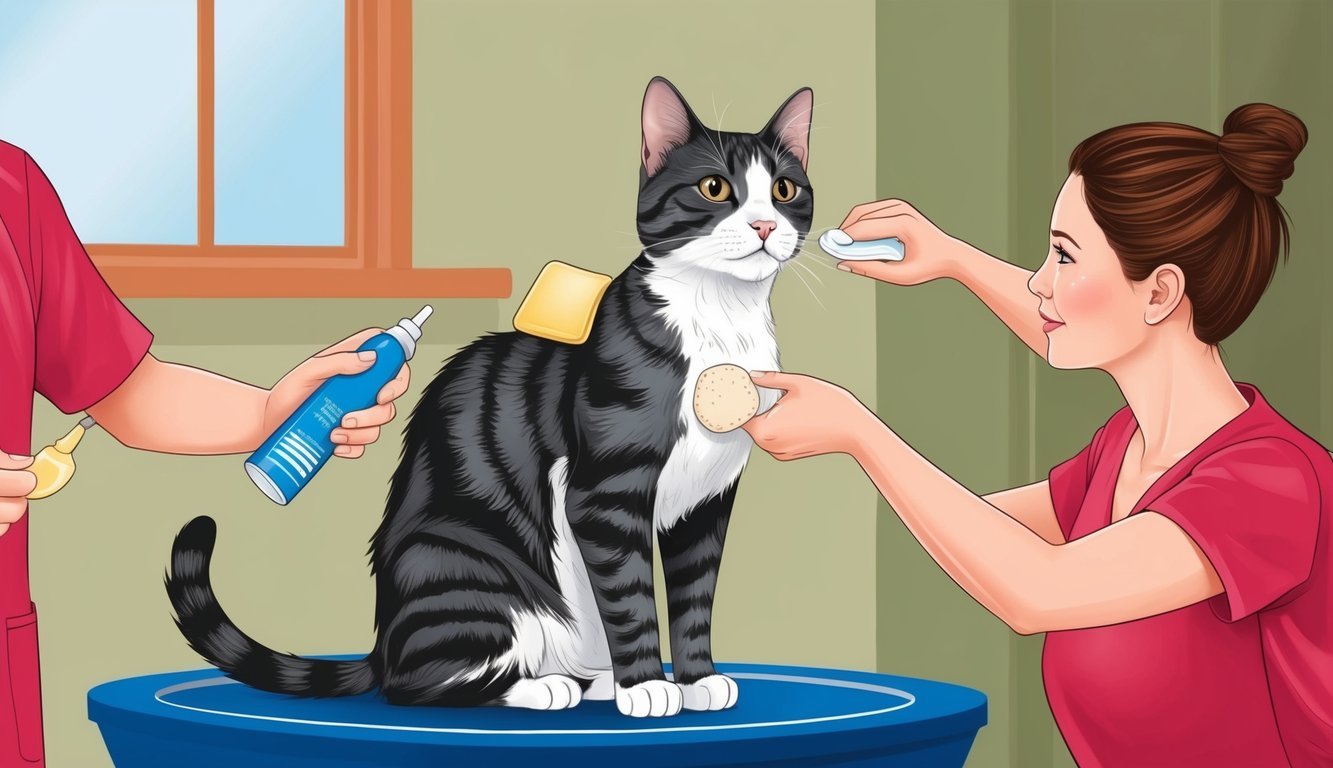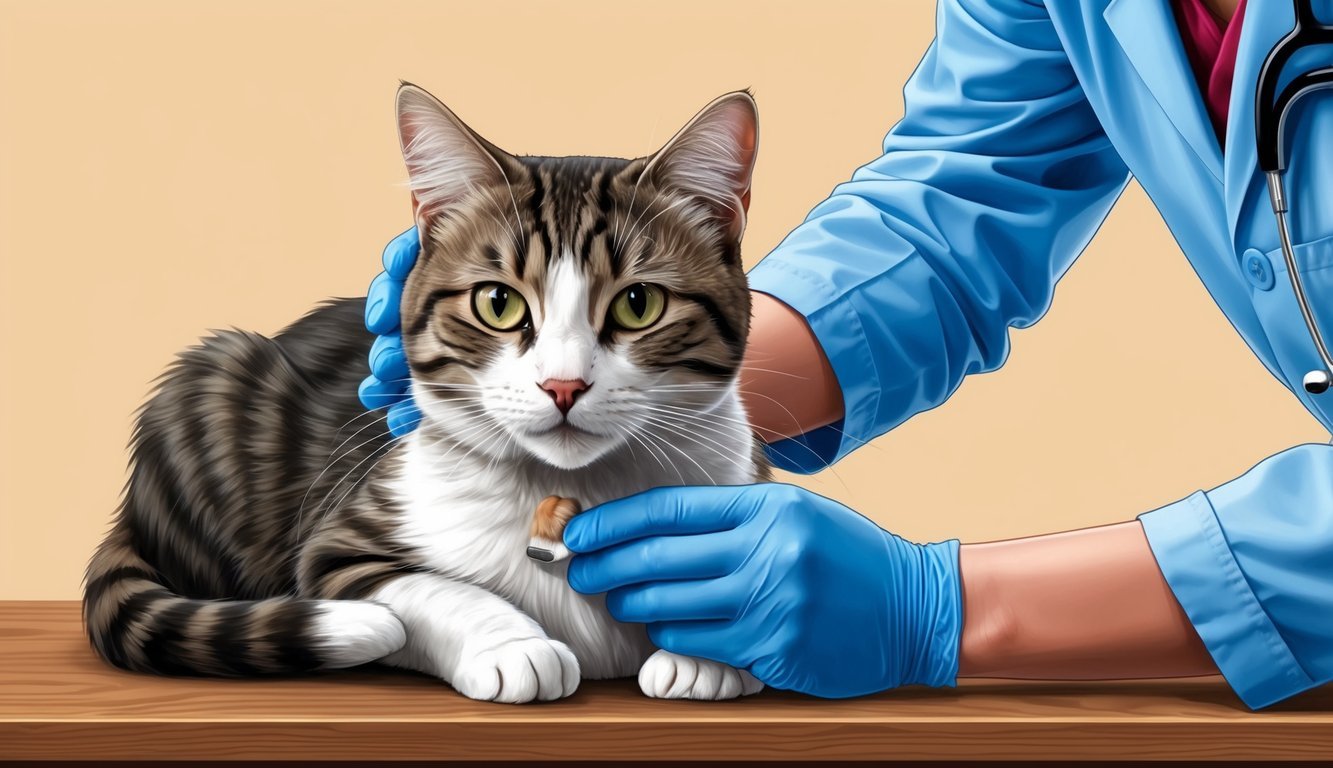Skin tags on cats can often be a cause for concern among pet owners.
These fleshy growths are usually harmless, but knowing how to identify them and when to seek veterinary advice can help ensure your feline friend stays healthy.
Understanding what skin tags are, their potential causes, and the treatment options available can make all the difference in managing your cat’s well-being.
You might notice these small bumps appearing on your cat’s body, often in areas prone to friction, such as under collars or harnesses.
While skin tags typically do not indicate serious health issues, they can occasionally become irritated.
Keeping an eye on their size and condition is key in determining whether they need to be evaluated by a vet.
In this article, you’ll learn how to identify skin tags, the factors that might contribute to their development, and the best ways to treat and prevent them.
This knowledge will empower you to care for your cat more effectively and address any concerns you may have.
Key Takeaways
- Skin tags are generally benign growths that can appear on your cat’s body.
- Factors like genetics and age can influence the development of skin tags.
- Monitor your cat’s skin tags and consult a vet if they change or cause irritation.
Understanding Skin Tags in Cats
Skin tags on cats are common benign growths, often harmless, but knowing more about them can help you ensure your cat’s well-being.
This section discusses what skin tags are and the different types of skin growths you might encounter on your feline friend.
What Are Skin Tags?
Skin tags, also known as acrochordons, are small, fleshy masses that can appear on various parts of your cat’s body.
They are usually flesh-colored and can be soft to the touch.
Typically, skin tags are composed of connective tissue, blood vessels, and collagen covered by skin.
These benign growths tend to remain stable in size, although some may grow gradually.
If you notice new skin tags or changes in existing ones, it’s always best to consult your veterinarian for proper evaluation.
Types of Feline Skin Growths
Feline skin growths come in various forms, and it’s essential to distinguish between them.
Common types include:
- Skin Tags (Acrochordons): Usually harmless and soft, often found around the neck or underarms.
- Papillomas: These viral growths can appear like warts and are generally benign.
- Lipomas: Soft, fatty tumors that commonly form under the skin.
Each of these growths has different characteristics and potential causes.
While most are non-threatening, recognizing the differences can help you identify when it may be necessary to seek veterinary advice.
Regular monitoring is important for early detection of any concerning changes.
Causes and Genetic Factors
Skin tags on cats can arise from a variety of factors.
Understanding these causes is crucial for any cat owner, especially for identifying when to seek veterinary care.
This section delves into common causes and how genetics may play a role in their development.
Common Causes of Skin Tags on Cats
Several factors contribute to the appearance of skin tags in cats. Friction is a significant cause; areas where collars or harnesses rub against the skin can develop tags.
Obesity is another common factor.
Overweight cats tend to have more skin folds, which increases the likelihood of skin tags forming.
It’s essential to monitor your cat’s weight and make adjustments to their diet if necessary.
Additionally, poor grooming habits can lead to skin tags.
Cats that don’t groom themselves adequately may experience skin irritations, potentially resulting in tags.
Lastly, exposure to certain chemicals or infections can also trigger skin tag growth.
Genetic Predisposition
Genetics can influence whether your cat is likely to develop skin tags.
Some breeds might show a hereditary tendency toward skin tag formation.
If a cat’s parents had skin tags, there’s a chance they might develop them too.
Hormonal imbalances can also affect skin health.
Cats that undergo hormonal changes, particularly as they age, may be more prone to skin tags.
In any case, if you notice changes in your cat’s skin or new growths, it’s always a good idea to consult your veterinarian for professional advice.
Identification and Signs
Identifying skin tags on your cat can be straightforward if you know what to look for.
Understanding the signs of these benign growths and recognizing when to seek veterinary advice is crucial for your cat’s health.
Recognizing Skin Tags on Your Cat
Skin tags in cats are typically small, fleshy masses that can vary in size and shape.
You may notice them on any part of your cat’s body, often appearing as:
- Flesh-colored bumps: These generally blend in with your cat’s skin.
- Soft texture: Skin tags are usually soft to the touch and may dangle slightly from a stalk.
- Growth pattern: Some tags stay small, while others may grow over time.
While skin tags are usually harmless, keep an eye on any changes.
If a tag changes color, grows rapidly, or becomes painful, it’s essential to consult your vet for a proper assessment.
When to See a Vet for Biopsy
You should consider a veterinary visit if you’re uncertain about a skin tag.
Signs that warrant attention include:
- Rapid Growth: If a skin tag quickly enlarges, it could indicate a problem.
- Changes in Color: Any darkening or unusual coloration should raise a red flag.
- Bleeding or Discharge: If a skin tag is bleeding or oozing, seek immediate veterinary advice.
While most skin tags are benign, it’s important to differentiate them from other skin conditions.
A vet may suggest a biopsy to rule out more serious issues.
Regular check-ups help ensure your cat remains healthy, so don’t hesitate to get a professional opinion when in doubt.
Treatment and Removal Options
When dealing with skin tags on your cat, it’s essential to assess whether removal is necessary and to understand the methods available for treatment.
Skin tags are generally benign but can require attention under certain conditions.
When to Consider Skin Tag Removal
You might need to think about skin tag removal if your cat shows signs of discomfort or if a tag is located in an area prone to irritation.
Tags that are frequently scratched or caught on objects can become inflamed or infected.
Additionally, if the skin tag changes in appearance, such as growing larger or changing color, consulting your vet is crucial.
In some cases, weight management may help reduce the formation of new skin tags, so maintaining a healthy weight can be beneficial.
Regular vet check-ups can help monitor your cat’s skin condition, ensuring any concerning changes are addressed promptly.
Removal Procedures
Your vet will determine the best removal procedure based on your cat’s health and the skin tag’s characteristics.
Common methods include:
-
Surgical Removal: This is often the preferred option for larger or problematic skin tags. The vet will use anesthesia for the procedure to ensure your cat is comfortable.
-
Cryotherapy: In this method, the tag is frozen using liquid nitrogen. This can effectively eliminate the tag without significant discomfort.
-
Cauterization: This involves using heat to remove the skin tag. Cauterization is typically quick and can minimize bleeding.
Your vet will discuss these options and help you choose the right one based on your cat’s specific needs.
Always ensure these procedures are performed by a qualified veterinarian for the best outcome and safety.
Prevention Strategies

Keeping your cat’s skin healthy can help prevent the formation of skin tags.
By incorporating some practical tips and regularly monitoring their skin health, you can reduce the risk of skin tags developing on your feline friend.
Practical Tips for Prevention
To help prevent skin tags on your cat, consider the following strategies:
-
Maintain a Healthy Weight: Obesity can lead to excess skin folds, increasing friction and the likelihood of skin tags. Ensure your cat has a balanced diet and regular exercise.
-
Groom Regularly: Regular brushing can help remove loose fur and debris, reducing irritation on the skin. Aim for at least once a week, or more often for long-haired breeds.
-
Check for Irritants: Ensure that collars and harnesses fit properly. Tight or irritating equipment can cause friction, leading to skin issues, including tags.
-
Provide a Clean Environment: Regularly clean your cat’s bedding and living areas to minimize allergens and irritants that could affect their skin health.
Monitoring Your Cat’s Skin Health
Keeping an eye on your cat’s skin can catch issues early.
Here are some tips:
-
Routine Check-Ups: Schedule regular veterinary visits. Your vet can monitor skin health and identify potential problems early.
-
Daily Skin Checks: Create a habit of checking your cat’s skin for any unusual lumps or growths. Look particularly in areas prone to friction.
-
Be Aware of Changes: Take note of any changes in your cat’s skin texture or behavior. If you notice excessive grooming, redness, or lumps, consult your vet.
-
Adjust Grooming Habits: If your cat develops skin irritation, consider changing grooming products. Opt for hypoallergenic shampoos or conditioners.
Staying proactive about your cat’s skin care can significantly contribute to their overall well-being.
Aftercare and Monitoring

Once your cat has had a skin tag removed, proper aftercare is essential for a smooth recovery.
Monitoring the area for any changes is also crucial to ensure long-term health.
Post-Removal Care
After the procedure, keep an eye on the removal site.
It’s normal for some redness and swelling to occur.
Ensure your cat doesn’t scratch or lick the area, as this can lead to infection.
You may need to use an Elizabethan collar to prevent this behavior.
Be sure to apply any prescribed medications as directed.
Monitor for signs of discomfort, such as excessive grooming or changes in behavior.
If you notice any unusual discharge or the area seems to worsen, reach out to your veterinarian promptly.
Ongoing Check-Ups and Observations
Regular check-ups with your vet are important, especially in the weeks following removal.
These visits help monitor for new skin growths.
Your vet can guide you on what to watch for and when to return for additional appointments.
Conduct routine examinations at home.
Gently feel your cat’s skin for any new bumps or changes in existing growths.
If you notice anything unusual, jot down your observations.
This will help your vet assess any potential issues during your next visit.
By staying vigilant, you promote your cat’s overall health.
Frequently Asked Questions

Skin tags on cats can raise several questions for pet owners.
Understanding their causes, management, and when to seek veterinary advice is essential for your cat’s health.
What could lead to the appearance of skin tags on my cat?
Skin tags on your cat might develop due to several factors, such as genetics, age, and skin friction.
Cats that are older may be more prone to them, and certain breeds may have a genetic predisposition.
Skin tags are generally harmless, but monitoring any changes is important.
Is there a way to safely remove skin tags from cats at home?
It’s not recommended to attempt removing skin tags from your cat at home.
Improper removal can lead to infection or bleeding.
Consult your veterinarian for safe and effective removal options, as they have the right tools and expertise.
How can I differentiate between a skin tag and a tumor on my cat?
Skin tags typically dangle from a stalk and feel soft and flesh-colored.
Meanwhile, tumors may feel firmer and can be irregular in shape or color.
If you notice any changes in size, shape, or if the growth feels hard, see your vet for an evaluation.
Should I be concerned about the skin tags on my cat’s neck?
Skin tags on your cat’s neck are usually harmless.
However, consult your veterinarian if you notice that the skin tag is growing quickly, causing discomfort, or becoming discolored.
They can provide a thorough examination to rule out any underlying conditions.
How can I tell a tick from a skin tag on my feline friend?
Ticks are usually dark and appear more rounded than skin tags, which are flesh-colored and often irregular.
Ticks are attached to the skin and may be engorged if they have been feeding.
If in doubt, use tweezers to carefully remove the tick or consult your vet for assistance.
At what point are skin tags on cats considered a serious issue?
Skin tags are typically not serious unless they change significantly in appearance, become painful, or cause irritation.
If your cat shows signs of discomfort or if the skin tag becomes infected, it’s time to seek veterinary care.
Regular check-ups can help you keep track of any changes.

